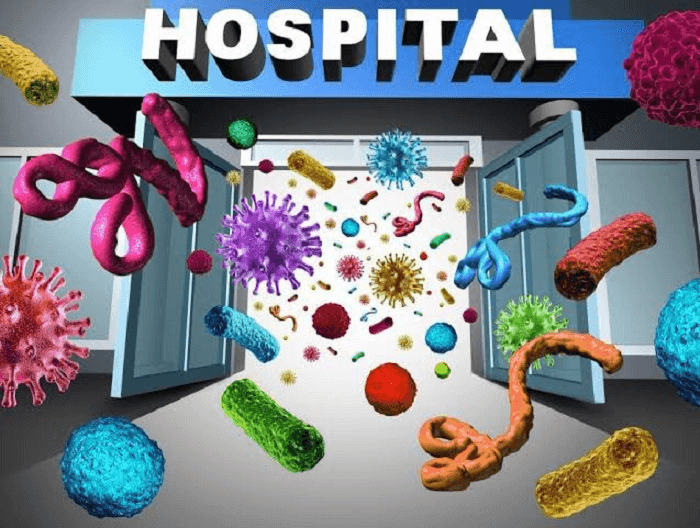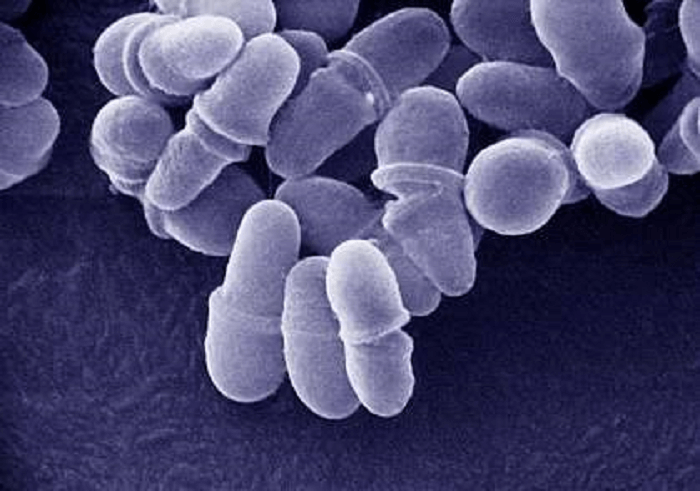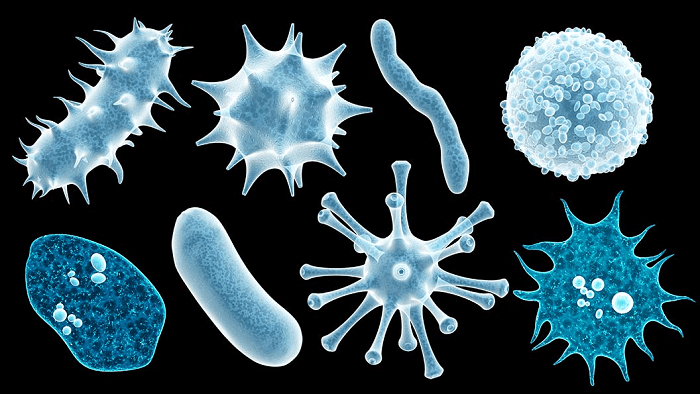Nosocomial Infections DefinitionNosocomial infections, also known as healthcare-associated infections (HAI), are illnesses acquired during the course of receiving health care that were not present at the time of admission. They can emerge in a variety of settings, including hospitals, long-term care institutions, and ambulatory settings, and they can also appear after discharge. HAIs may also involve occupational infections that affect employees. When pathogen(s) infect a vulnerable patient host, infection occurs. In modern healthcare, these infections are linked to invasive treatments and surgery, as well as indwelling medical devices and prosthetic devices. HAI aetiology is determined by the source or kind of infection as well as the pathogen responsible, which can be bacterial, viral, or fungal. 
HAI is the most typical adverse event in healthcare that compromises patient safety. They place a heavy financial strain on individuals, families, and healthcare systems while also significantly increasing morbidity, mortality, and financial cost. An additional HAI issue is the growth of multi-drug resistance microbes. 6.5% of all hospitalised patients in the European Union/European Economic Area and 3.2% of all hospitalised patients in the United States have HAI, and the prevalence is likely substantially greater globally. Because there are no HAI surveillance systems, it is unknown how often HAIs are globally. The development of monitoring systems and infection control techniques has, however, been the focus of intense work by infection prevention and control programmes. Some of the numerous intrusive treatments and technologies used in contemporary healthcare, according to the Centres for Disease Control and Prevention (CDC)Trusted Source, can help spread infections. These methods and tools include:
Types of Nosocomial InfectionsThe germs that are accountable for infections come from a range of origins and have many distinct forms. According to the Centres for Disease Control and Prevention, there are several different forms of nosocomial infections:
Other nosocomial infections or HAIs include non-ventilator-associated hospital-acquired pneumonia (NV-HAP), gastroenteritis (including Clostridioides difficile), additional primary bloodstream infections not connected to central catheter use, and additional urinary tract infections not connected to catheter use. Infections of the ear, nose, throat, lower respiratory tract (including bronchitis, tracheobronchitis, bronchiolitis, tracheitis, lung abscess or empyema without evidence of pneumonia), skin and soft tissue, cardiovascular, bone and joint, central nervous system, and reproductive tract infections are other ways to categorise HAI. A point-prevalence survey conducted in the United States in 2015 showed that the most common HAI in acute hospital settings is pneumonia, followed by gastrointestinal infections, SSI, other infections of the systems, as mentioned earlier, bloodstream infections, and urinary tract infections. The prevalence of these types of infections has changed from point-prevalence surveys in 2011, which showed pneumonia (21.8%) and SSI (21.8%) as the most common, followed by gastrointestinal (17.1%), urinary tract (12.9%), bloodstream (9.9%) and other infections. Interestingly, this same study showed that NV-HAP is the most common type of HAI in the acute health care setting, which is consistent with studies conducted in Europe. Organisms ResponsibleBacteria, viruses, and fungus are pathogens that cause nosocomial infections. Particular bacteria have distinctive properties that favour specific sorts of diseases in vulnerable hosts. Depending on the location of the healthcare institution, the environment, and the patient group, different microorganisms have different prevalence rates. The most prevalent infections are often bacteria, followed by fungi and viruses. Bacteria
Bacteria may originate from an exogenous or endogenous source as part of the natural flora. Opportunistic bacterial infections occur when there is a breakdown of the host immune system functions. Common Gram-positive organisms include coagulase-negative Staphylococci, Staphylococcus aureus, Streptococcus species, and Enterococcus species (e.g. fecal, faecium). The majority of infections with a reported pathogen (15%) in US hospitals are caused by C.difficile, the pathogen most frequently related to HAI. Common Gram-negative bacteria include members of the Enterobacteriaceae family, such as Klebsiella pneumoniae and Klebsiella oxytoca, Escherichia coli, Proteus mirabilis, and Enterobacter species, as well as Pseudomonas aeruginosa, Acinetobacter baumanii, and Burkholderia cepacia. Acinetobacter baumanii is linked to a high mortality rate in the intensive care setting because of its innate multi-drug resistance characteristics. Multidrug-resistant bacteria are commonly seen in HAI and are associated with significant mortality. One study found that approximately 20% of all reported pathogens show multidrug-resistant patterns. Notorious pathogens include methicillin-resistant Staphylococcus aureus (MRSA), Vancomycin-intermediate Staphylococcus aureus (VISA), and Vancomycin-resistant Staphylococcus aureus (VRSA), Enterobacteriaceae with extended-spectrum cephalosporin resistance consistent with extended-spectrum beta-lactamase (ESBL) production, vancomycin-resistant Enterococcus (VRE), carbapenem-resistant Enterobacteriaceae and Acinetobacter species, and multi-drug resistant Pseudomonas aeruginosa. Fungi
In immunocompromised individuals and those who have indwelling devices, such as central lines or urinary catheters, fungi are typically linked to opportunistic infections. The most frequent fungi found in HAI cases are members of the Candida genus, including C. albicans, C. parapsilosis, and C. glabrata. Due to its difficulties in diagnosing and high rates of treatment failure, Candida auris poses a substantial threat as a rapidly spreading, multidrug-resistant organism with significant morbidity and mortality. The fourth most frequent pathogen overall among all HAI types is a member of the Candida genus. In regions where hospitals are being built, Aspergillus fumigatus may be spread through the air through environmental contamination. But a primary source could be sick hospitalised patients. Viruses
Viral pathogens account for 1-5% of all HAI pathogens, but viral infections are the least frequently observed. Unsafe needle practises have been linked to human deficiency virus (HIV), hepatitis B and C acquired in a healthcare setting, and both. 5.4% of HIV infections worldwide are healthcare-related and typically take place in developing nations. The following viral pathogens have also been identified: influenza, rotavirus, herpes simplex, rhinovirus, and cytomegalovirus. EpidemiologyNumerous people around the world are affected by nosocomial infections, which increases mortality and has a negative cost impact on healthcare systems. Epidemiologic research from Europe and the United States reveal reasonably consistent results in surveillance programmes, despite the fact that the true worldwide burden of healthcare-associated infection (HAI) is still unclear due to the absence of trustworthy data and surveillance systems. As a result, the majority of epidemiologic studies originate in the US and Europe. In European hospitals, the incidence of at least one HAI varied depending on the kind of care setting: 4.4% in primary care hospitals, 7.1% in tertiary care hospitals, 19.2% in intensive care units, and 3.7% in long-term care facilities. In emergency rooms and long-term healthcare facilities in the European Union, it has been determined that there are roughly 8.9 million different HAI events every year. The European Prevalence of Infection in Intensive Care (EPIC) study from 1995 found that the prevalence of ICU-acquired infections was 20.6%. According to a survey conducted in 2015, the frequency of HAI among hospitalised patients in the US was 3.2%, which was much lower than the 4% found in a study from 2011. According to the same study, of all HAI in US medical institutions, 36.4% were linked to critical care settings, 57.5% to ward or nursery settings, 6.1% to step-down or specialty care units, or mixed acuity settings (various levels of acute care). According to a previous study, the rate of HAI acquisition was highest in nurseries for high-risk newborns, adults and children not in the intensive care unit, ICU patients, and then nurseries for healthy babies. In 2015, there were 687,200 HAI cases reported in US hospitals, impacting 633,300 patients. In contrast to estimates from 2002, which put the yearly number of HAI in US hospitals at 1.7 million, these figures are encouraging. The prevalence of HAI seems to be greater in poorer nations. According to a pooled review of data from developing nations, the prevalence of HAI is 15.5%, with the majority of cases occurring as newborn infections and ventilator-associated pneumonia (VAP) in intensive care settings. In Southeast Asian nations, a systemic evaluation of HAI indicated that the total frequency was 9.1%. Transmission RoutesDifferent transmission pathways may be used by pathogens linked to healthcare-associated infections (HAI). touch is the most frequent method of transmission, when the organisms are spread through either direct or indirect touch. Multidrug-resistant bacteria (including MRSA, ESBL-producing Gram-negative organisms, VRE), C. difficile, and rotavirus are frequently transmitted germs that can be spread by touch. When bacteria are transported from the respiratory system by big droplets (more than 5 microns) and travel a distance of less than 3 feet, droplet transmission may happen. Neisseria meningitides, Bordetella pertussis, and influenza are a few examples of infectious organisms that spread through droplets. Airborne transmission is the long-distance spread of microorganisms from the respiratory system using droplets smaller than 5 microns. The new SARS-COV-2 virus, the chickenpox virus, TB, and measles can all spread via the air. Central Line-Associated Blood Stream Infection (CLABSI)The most avoidable form of HAI is CLABSI, which develops in the context of a central venous line (CVC). CVC affects 24% of non-ICU patients and 55% of patients in intensive care units in the US. In most cases, CLABSI happens when skin-surface bacteria spread along the catheter's exterior and into the vascular section. CLABSI can also arise as a result of hematogenous seeding, contamination of the CVC during insertion or manipulation, or both. Host and catheter variables might be classified as CLABSI risk factors. Immunocompromised conditions such as long-term sickness, neutropenia, undernutrition, parenteral nutrition, extreme ages, and bone marrow transplants are examples of host factors. The length of the hospital stay before the catheterization, the length of the catheterization itself, the number of CVCs, the number of lumens, the material of the catheters, the urgency of insertion, and the absence of sterile barriers or breakdowns in the aseptic technique are all catheter variables. Some people question if femoral CVC carries a higher risk of CLABSI than subclavian or jugular locations. Catheter-Associated Urinary tract Infection (CAUTI)An indwelling urinary catheter, which may be implanted for a variety of medical reasons, may cause a CAUTI, or catheter-associated urinary tract infection. In the United States, between 15 and 25 percent of hospitalised patients are using a urinary catheter. CAUTI can be extraluminal or intraluminal. Bacteria that travel through the catheter's extraluminal surface and enter the bladder through the urethral meatus are known as extraluminal infections. When there is urinary stasis, which is typically caused by obstructed drainage or ascending infection from the intraluminal side of a contaminated catheter, intraluminal infection develops. The length of catheterization is the main risk factor for CAUTI. Another risk factor that can be changed is adherence to the operative or insertion protocol, such as using aseptic techniques. Female sex, paraplegia, cerebrovascular disease, advanced age, diabetes mellitus, a history of UTI in the previous year, and recent antibiotic usage within 90 days are patient features that enhance risk. Skin and Soft Tissue Infection (SSI)SSI happens in 2-5% of patients who have surgery, and it typically shows up 30 days after the procedure or 90 days after the procedure. The type of SSI is determined by the depth and location of the infection: Only the skin and subcutaneous tissues are involved in superficial SSI; deep SSI affects the muscle or facia, and organ- or space-specific SSI is present in the anatomic region of surgery. Depending on where the surgery is being performed, the patient's skin, gastrointestinal system, and female vaginal tract serve as a reservoir for the healthy flora that can infect the surgical site. Risk factors associated with the procedure include the length of the procedure, the type of wound, hypothermia and hypovolemia during the procedure, hypoxemia, the need for several interventions or surgeries, the need for blood transfusions, and the type of prosthesis implanted. The length of the procedure is the most important risk factor since the longer it takes, the more likely it is that contaminated tissue will be exposed to the environment. Another crucial factor to take into account is the wound class; clean wounds are less at risk than those that are dirty, contaminated, or clean-contaminated. The use of wound drains, poor wound hygiene, and duration of stay following surgery are postoperative risk factors. Immunosuppression, tobacco use, obesity, hyperglycemia, malnutrition, joint disease, and growing older are all risk factors specific to the patient. PneumoniaPneumonia picked up in a hospital is pneumonia that appears 48 hours after being admitted. The development of ventilator-associated pneumonia occurs 48 hours following endotracheal intubation. VAP affects 5 to 15% of people who are mechanically ventilated. Patients get HAP from aspirating, breathing in polluted aerosols, translocating germs, and hematogenously spreading the disease. The pathogens Klebsiella oxytoca and pneumonia, Streptococcus species, Enterobacter species, S. aureus, P. aeruginosa, Candida species, Klebsiella oxytoca, and pneumonia are frequently linked to HAP and VAP. In VAP, it is typical to find organisms that are multi-drug resistant. Host vulnerability is influenced by both local and systemic variables, including age over 70, immunosuppression, neutropenia, dysphagia, and recent abdominal or thoracic surgery. Local factors include underlying lung illness.
Next TopicOmnivores Definition
|
 For Videos Join Our Youtube Channel: Join Now
For Videos Join Our Youtube Channel: Join Now
Feedback
- Send your Feedback to [email protected]
Help Others, Please Share










